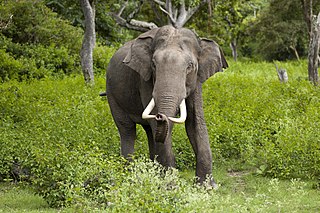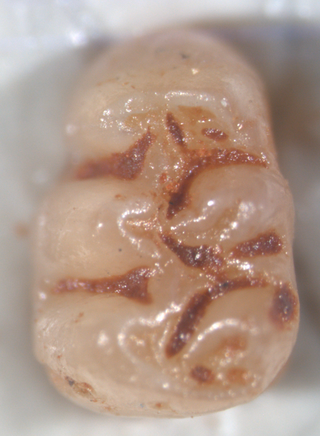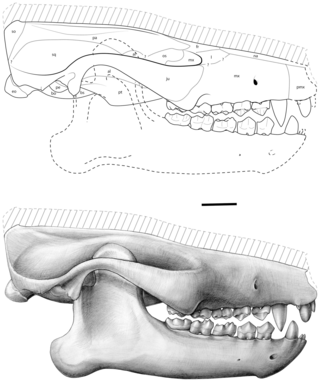
Proboscidea is a taxonomic order of afrotherian mammals containing one living family (Elephantidae) and several extinct families. First described by J. Illiger in 1811, it encompasses the elephants and their close relatives. From the mid-Miocene onwards, most proboscideans were very large. The largest land mammal of all time may have been a proboscidean; Palaeoloxodon namadicus was up to 5.2 m (17.1 ft) at the shoulder and may have weighed up to 22 t, almost double the weight of some sauropods like Diplodocus carnegii. The largest extant proboscidean is the African bush elephant, with a record of size of 4 m (13.1 ft) at the shoulder and 10.4 t. In addition to their enormous size, later proboscideans are distinguished by tusks and long, muscular trunks, which were less developed or absent in early proboscideans.

The molars or molar teeth are large, flat teeth at the back of the mouth. They are more developed in mammals. They are used primarily to grind food during chewing. The name molar derives from Latin, molaris dens, meaning "millstone tooth", from mola, millstone and dens, tooth. Molars show a great deal of diversity in size and shape across mammal groups. The third molar of humans is sometimes vestigial.

A mastodon is any proboscidean belonging to the extinct genus Mammut. Mastodons inhabited North and Central America from the late Miocene up to their extinction at the end of the Pleistocene 10,000 to 11,000 years ago. Mastodons are the most recent members of the family Mammutidae, which diverged from the ancestors of elephants at least 25 million years ago. M. americanum, the American mastodon, is the youngest and best-known species of the genus. They lived in herds and were predominantly forest-dwelling animals. M. americanum is inferred to have had a browsing diet with a preference for woody material, distinct from that of the contemporary Columbian mammoth. Mastodons became extinct as part of the Quaternary extinction event that exterminated most Pleistocene megafauna present in the Americas, believed to have been caused by a combination of climate changes at the end of the Pleistocene and hunting by recently arrived Paleo-Indians, as evidenced by a number of kill sites where mastodon remains are associated with human artifacts.

Elephantidae is a family of large, herbivorous proboscidean mammals collectively called elephants and mammoths. These are large terrestrial mammals with a snout modified into a trunk and teeth modified into tusks. Most genera and species in the family are extinct. Only two genera, Loxodonta and Elephas, are living.

Mammutidae is an extinct family of proboscideans that appeared during the Oligocene epoch and survived until the start of the Holocene. Mammutids ranged very widely, with fossils found in North America, Africa, and throughout Eurasia. The family was first described in 1922, classifying fossil specimens of the type genus Mammut (mastodons), and has since been placed in various arrangements of the order. The name "mastodon" derives from Greek, μαστός "nipple" and ὀδούς "tooth", as with the genus, referring to their characteristic teeth that distinguishes them from other proboscideans.

Moeritherium is an extinct genus of primitive proboscideans. These prehistoric mammals are related to the elephant and, more distantly, sea cows and hyraxes. They lived during the Eocene epoch.

Anancus is an extinct genus of "tetralophodont gomphothere" native to Afro-Eurasia, that lived from the Tortonian stage of the late Miocene until its extinction during the Early Pleistocene, roughly from 8.5–2 million years ago.

Numidotherium is an extinct genus of early proboscideans, discovered in 1984, that lived during the middle Eocene of North Africa some 46 million years ago. It was about 90-100 cm tall at the shoulder and weighed about 250-300 kg.

Phosphatherium escuillei is a basal proboscidean that lived from the Late Paleocene to the early stages of the Ypresian age until the early Thanetian some 56 million years ago in North Africa. Research has suggested that Phosphatherium existed during the Eocene period.

Tetralophodon is an extinct genus of "tetralophodont gomphothere" belonging to the superfamily Elephantoidea, known from the Miocene of Afro-Eurasia.

Ambondro mahabo is a mammal from the Middle Jurassic (Bathonian) Isalo III Formation of Madagascar. The only described species of the genus Ambondro, it is known from a fragmentary lower jaw with three teeth, interpreted as the last premolar and the first two molars. The premolar consists of a central cusp with one or two smaller cusps and a cingulum (shelf) on the inner, or lingual, side of the tooth. The molars also have such a lingual cingulum. They consist of two groups of cusps: a trigonid of three cusps at the front and a talonid with a main cusp, a smaller cusp, and a crest at the back. Features of the talonid suggest that Ambondro had tribosphenic molars, the basic arrangement of molar features also present in marsupial and placental mammals. It is the oldest known mammal with putatively tribosphenic teeth; at the time of its discovery it antedated the second oldest example by about 25 million years.

Eritherium is an extinct genus of early Proboscidea found in the Ouled Abdoun basin, Morocco. It lived about 60 million years ago. It was first named by Emmanuel Gheerbrant in 2009 and the type species is Eritherium azzouzorum. Eritherium is the oldest, smallest and most primitive known elephant relative.

Brachytarsomys mahajambaensis is an extinct rodent from northwestern Madagascar. It is known from nine isolated molars found in several sites during fieldwork that started in 2001. First described in 2010, it is placed in the genus Brachytarsomys together with two larger living species, which may differ in some details of molar morphology. The presence of B. mahajambaensis, a rare element in the local rodent fauna, suggests that the region was previously more humid.

Agathaeromys is an extinct genus of oryzomyine rodents from the Pleistocene of Bonaire, Netherlands Antilles. Two species are known, which differ in size and some details of tooth morphology. The larger A. donovani, the type species, is known from hundreds of teeth that are probably 900,000 to 540,000 years old, found in four localities. A. praeuniversitatis, the smaller species, is known from 35 teeth found in a single fossil site, which is probably 540,000 to 230,000 years old.
Galerix kostakii is a fossil erinaceid mammal from the early Miocene of Greece. It is known from the site of Karydia, assigned to the biostratigraphical zone MN 4; similar fossils have been found at an approximately contemporary Czech site and a slightly younger Greek site. With characters like the presence of a hypocone on the upper third premolar, the presence of a connection between the protocone and metaconule cusps on the second upper molar in only a few specimens, this species is intermediate between the slightly older Galerix symeonidisi and the slightly younger Parasorex pristinus. It may form part of the lineage leading from the genus Galerix to the younger genus Parasorex.
Dermotherium is a genus of fossil mammals closely related to the living colugos, a small group of gliding mammals from Southeast Asia. Two species are recognized: D. major from the Late Eocene of Thailand, based on a single fragment of the lower jaw, and D. chimaera from the Late Oligocene of Thailand, known from three fragments of the lower jaw and two isolated upper molars. In addition, a single isolated upper molar from the Early Oligocene of Pakistan has been tentatively assigned to D. chimaera. All sites where fossils of Dermotherium have been found were probably forested environments and the fossil species were probably forest dwellers like living colugos, but whether they had the gliding adaptations of the living species is unknown.
Indraloris is a fossil primate from the Miocene of India and Pakistan in the family Sivaladapidae. Two species are now recognized: I. himalayensis from Haritalyangar, India and I. kamlialensis from the Pothohar Plateau, Pakistan. Other material from the Potwar Plateau may represent an additional, unnamed species. Body mass estimates range from about 2 kg (4.4 lb) for the smaller I. kamlialensis to over 4 kg (8.8 lb) for the larger I. himalayensis.

Ocepeia is an extinct genus of afrotherian mammal that lived in present-day Morocco during the middle Paleocene epoch, approximately 60 million years ago. First named and described in 2001, the type species is O. daouiensis from the Selandian stage of Morocco's Ouled Abdoun Basin. A second, larger species, O. grandis, is known from the Thanetian, a slightly younger stage in the same area. In life, the two species are estimated to have weighed about 3.5 kg (7.7 lb) and 10 kg (22 lb), respectively, and are believed to have been specialized leaf-eaters. The fossil skulls of Ocepeia are the oldest known afrotherian skulls, and the best-known of any Paleocene mammal in Africa.
Sivaladapis is a genus of adapiform primate that lived in Asia during the middle Miocene.
Dagbatitherium is an extinct genus of proboscideans. So far a single molar from the phosphate basins of Togo in West Africa has been found. The fossil dates to the Middle Eocene, around 47 million years ago. A striking feature of the tooth are the three pairs of cusps oriented transversely to the longitudinal axis of the tooth. This feature is found in more derived proboscideans, which are grouped in the Elephantiformes. For its age, Dagbatitherium is the earliest member of Elephantiformes to date. Furthermore, it is characterized by a low tooth crown and a humped occlusal pattern. The genus was described in 2021.

















